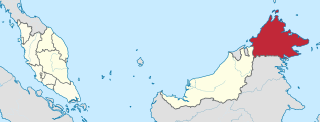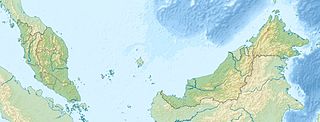
Sabah is a state of Malaysia located on the northern portion of Borneo, in the region of East Malaysia. Sabah has land borders with the Malaysian state of Sarawak to the southwest and Indonesia's Kalimantan region to the south. The Federal Territory of Labuan is an island just off the Sabah coast. Sabah shares maritime borders with Vietnam to the west and the Philippines to the north and east. Kota Kinabalu is the state capital city, the economic centre of the state, and the seat of the Sabah state government. Other major towns in Sabah include Sandakan and Tawau. As of the 2015 census in Malaysia, the state's population is 3,543,500. Sabah has an equatorial climate with tropical rainforests and abundant animal and plant species. The state has long mountain ranges on the west side which forms part of the Crocker Range National Park. Kinabatangan River, the second longest river in Malaysia runs through Sabah, and Mount Kinabalu is the highest point of Sabah as well as of Malaysia.

Kota Kinabalu is the state capital of Sabah, Malaysia. It is also the capital of the Kota Kinabalu District as well as the West Coast Division of Sabah. The city is located on the northwest coast of Borneo facing the South China Sea. The Tunku Abdul Rahman National Park lies to its west and Mount Kinabalu, which gave the city its name, is located to its east. Kota Kinabalu has a population of 452,058 according to the 2010 census; when the adjacent Penampang and Putatan districts are included, the metro area has a combined population of 628,725.

Tawau formerly known as Tawao, is the capital of the Tawau District in Sabah, Malaysia. It is the third-largest town in Sabah, after Kota Kinabalu and Sandakan. It is located on the Semporna Peninsula in the southeast coast of the state in the administrative centre of Tawau Division, which is bordered by the Sulu Sea to the east, the Celebes Sea to the south at Cowie Bay and shares a border with North Kalimantan, Indonesia. The town had an estimated population as of 2010, of 113,809, while the whole municipality area had a population of 397,673.

The National Museum is a museum located on Jalan Damansara in Kuala Lumpur, Malaysia. The museum is situated in close proximity to the Perdana Lake Gardens and it provides an overview of Malaysian history and culture. Its facade comprises elements of traditional Malay and modern features. It was opened on 31 August 1963, and it serves as a repository of Malaysia's rich cultural and historical heritage.

Semporna is the capital of the Semporna District in the Tawau Division of Sabah, Malaysia. Its population was estimated to be around 35,301 in 2010.

The Sama-Bajau refers to several Austronesian ethnic groups of Maritime Southeast Asia. The name collectively refers to related people who usually call themselves the Sama or Samah ; or are known by the exonym Bajau. They usually live a seaborne lifestyle and use small wooden sailing vessels such as the perahu, djenging (balutu), lepa, and vinta (pilang). Some Sama-Bajau groups native to Sabah are also known for their traditional horse culture.

Tawau Airport is an airport located 15 nautical miles north east of Tawau, Sabah, Malaysia. It is one of two airports in Sabah with immigration counters for international flights, the other being Kota Kinabalu International Airport. Tawau Airport serves the districts of Tawau, Kunak and Semporna and is the nearest airport to the diving islands of Sipadan, Mabul and Kapalai, all of which are located in the latter district.

This article lists important figures and events in Malaysian public affairs during the year 2002, together with births and deaths of notable Malaysians.

Datuk Seri Panglima Shafie bin Apdal is a Malaysian politician who served as the 15th Chief Minister and the State Minister of Finance of Sabah from May 2018 to September 2020 following defeat of his coalition, Sabah Heritage Party + in the 2020 state election. He has served as the Member of Parliament (MP) for Semporna since April 1995 and Member of the Sabah State Legislative Assembly (MLA) for Senallang since May 2018. He was the Minister of Rural and Regional Development and Vice-President of the United Malays National Organisation (UMNO), the leading party in the then-ruling Barisan Nasional (BN) coalition. He is the founding President of WARISAN, the opposition party of Sabah that is allied with the Pakatan Harapan (PH) opposition coalition.

Mount Bombalai is a volcanic cone mountain in the Tawau Division of Sabah, Malaysia. It reaches a height of approximately 531 metres (1,742 ft).

The Sabah Museum is the state museum of Sabah, Malaysia. It is sited on 17 hectares of land at Bukit Istana Lama in Kota Kinabalu, the state capital.

The history of Sabah can be traced back to about 23–30,000 years ago when evidence suggests the earliest human settlement in the region existed. The history is interwoven with the history of Brunei and the history of Malaysia, which Sabah was previously part of and is currently part of respectively. The earliest recorded history of Sabah being part of any organised civilisation began in the early 15th century during the thriving era of the Sultanate of Brunei. Prior to this, early inhabitants of the land lived in predominantly tribal societies, although such tribal societies had continued to exist until the 1900s. The eastern part of Sabah was ceded to the Sultan of Sulu by the Sultan of Brunei in 1658 for the former helping a victory over Brunei enemies, but many sources stated it had not been ceded at all. By the late 19th century, both territories previously owned by Sultan of Brunei and Sultan of Sulu was granted to British syndicate and later emerged as British North Borneo under the management of the North Borneo Chartered Company. Sabah became a protectorate of the United Kingdom in 1888 and subsequently became a Crown colony from 1946 until 1963, during which time it was known as Crown Colony of North Borneo. On 16 September 1963, Sabah merged with Malaya, Sarawak and Singapore to form Malaysia.

Tun Datuk Seri Panglima Sakaran Mohd Hashim bin Dandai is a Malaysian politician who served as the eighth Chief Minister and Governor of the Malaysian state of Sabah.

Pogunon Community Museum is a museum located at Pogunon Village in Penampang District of Sabah, Malaysia.

Keningau Heritage Museum is a museum located at Mahathir Park in Keningau of Sabah, Malaysia.

Sandakan Heritage Museum is a museum located at the 1st floor of Wisma Warisan building in Sandakan of Sabah, Malaysia. The museum building is located next to the Sandakan Municipal Council and is part of the Sandakan Heritage Trail.

Sabah Islamic Civilisation Museum is a 2-storey museum building located at Menteri Street in Kota Kinabalu District of Sabah, Malaysia.
Muzium Mat Sator is a museum in Old Kapayan Village in Tambunan District of Sabah, Malaysia. It is named after the follower and chief lieutenant of Mat Salleh, Mat Sator. The museum is located around 122-metre from the area of the Fort of Mat Salleh.



















